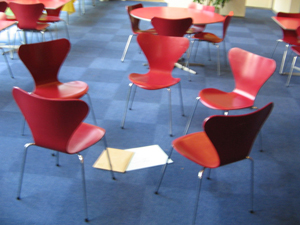
At first sight, the famous circle of chairs pretends that non-formal education is an orderly system, full of predictable harmony. What an illusion!
» Non-formal education is chaos at its best.
The contrast between the image and the core of nonformal learning is a wonderful illustration of the dialectics between order and chaos, harmony and disorder. And indeed, educators have much to gain from chaos theory.

In Greek mythology, the world wide web reveals to us, khaos meant “gaping void” or “nothingness” and was — at least by some — thought to be the primary source of all things.
In contemporary mathematics, chaos describes dynamical systems with a sensitive dependence on initial conditions.
More commonly, this is described as the butterfly effect, a term coined by mathematician and meterologist Edward Lorenz:
«Does the flap of a butterfly’s wings in Brazil set off a tornado in Texas?»
Lorenz described how small changes in the variables of his computer weather model grossly changed the predicted weather patterns and developed a model to calculate how even the tiniest variations of initial conditions can amplify and induce large variations in a system’s behaviour.

With his discovery he — according to the committee that awarded him the 1991 Kyoto Prize for basic sciences —
«profoundly influenced a wide range of basic sciences and brought about one of the most dramatic changes in mankind’s view of nature since Sir Isaac Newton.»
Discovered by Henri Poincaré in 1890, chaos boomed after Lorenz stumbled over it with his attempts at weather prediction in the 1960-ies. Chaos is now believed to have been observed in fluid dynamics, in magnetic fields, in molecular vibrations, and the solar system.
» Nonformal education needs to added to the list.
What makes a system chaotic?
To be classified as chaotic, a system needs to be not only sensitive to initial conditions, but also nonlinear. What is a nonlinear system you ask?
That might be understood easiest by looking at linear systems, so by looking at what nonlinear systems are not. A linear system always responds predictably: at a given place and time, several independent impulses always trigger the same reaction — whether they were applied separately or jointly. The sum of the responses is equal to the sum of the stimuli.

In nonlinear systems, this is not the case. The response of a system largely depends on the timing, order and combination of inputs. Clearly, for nonformal education this is the case.
Another way to approach the differentiation between linear and nonlinear systems is by their appearance. Linear systems appear the same, no matter how they are looked at. Nonlinear systems look different depending on your perspective. Again, this is true for any learning situation — how close or distant you are, or how involved or excluded in the proceedings, greatly determines how it all looks.
unpredictable
chaos
Nonlinear dynamical systems often behave in ways that seem completely random and are (seemingly) unpredictable — at least we cannot predict their behaviour with what we know. This unpredictability is called chaos.

To the day, weather systems remain a perfect example for such dynamics. Weather forecasts also help to clarify a common misperception of chaotic systems: chaos can, many people believe, not be determined. After all, how often has it rained when Mr Weatherman told us it wouldn’t?
But chaos can be understood. Or could be — if we knew enough about initial conditions, stimuli and responses; and if our knowledge was precise enough. Theoretically, chaotic systems are completely deterministic!
we knew enough!
Again, this holds true for non-formal education. If we knew enough about the people in advance — say about their history, their patterns of behaviour, and their ways of thinking, to name but a few aspects of relevance — we might be able to determine how a learning situation evolves.
To a certain extent we try this, of course: we ask particular questions in application forms, we develop pre-course questionnaires, we build curricula in certain ways and run complex, challenging activities not on the first day of an activity.

As in mathematics, we are not trying to find precise solutions or perfect responses (how hopeless would that be!), but rather to determine how the system depends on (which) initial conditions and whether the system can be transformed to a steady state, whatever that may look.
If we knew exactly the personalities and behavorial patterns of participants AND the entire range of external influences AND the complete diversity of deterministic factors, we might be able to predict better how a learning situation evolves.
But how silly would that be? Nobody wants that. And even if we ever knew all these things, we would still only know the starting point — approximately. Our knowledge of the complete set of influential conditions for a learning system will never be exact enough; the complexity is simply too large.
unwanted, too.
I am not complaining: one of the principles of non-formal education is anyway to not control, but facilitate; to not demand, but offer; to not enforce, but enable.
In other words: prediction is, in our work, not only theoretically impossible, it is also philosophically not wanted. Nonformal education is deliberately fortuitous. But while things may be chaotic, they are certainly not random.
What can we learn from all this?

First thoughts go to the attempts of defining quality factors of non-formal education.
Seeing the wide range of factors that influence any learning situation — and there is not even agreement on what these factors are, not to speak of what their influence may be — it seems almost silly (and certainly vain) trying to define an endless list of quality criteria.
Can this be done at all?
Some people, for example, pay great attention to the quality of the venue. But haven’t we all experienced shitty courses in gritty places, and witty courses in shitty places?
Second thoughts go to toolboxes and the attempt to standardise educational methodology.
Keeping the unpredictability of learning systems in mind: can our response really be to have a limited set of tools at the ready?
I think not. A criteria for quality — returning to the previous question — emerging from this discussion may well be the ability of teams to develop new methodological approaches in response to a particular situation.

Third thoughts go to attitudes of educators.
What we do, at all times, is chaos control — no more, no less. Don’t we too often pretend we control the entire situation? We do not; we merely influence some aspects of a learning system’s chaotic behaviour.
A new, appreciative openness to surprises is needed. But being open to the unexpected is not enough: the unexpected is part of any learning system’s inherent logic — it makes these complex systems functional.

Final thoughts go to evaluation.
A defining characteristic of chaos is that the sum of the total is not equal to the sum of its different parts and their interaction. There is more to chaos than the naked eye can see.
Why then, do I ask, do we continue
to dissect educational activities?
Why then do we continue to look at the different aspects of a training — aims, objectives, outcomes, competences, methodology, support — and pretend that all of this taken together fully captures the activity?
It doesn’t; and according to chaos theory it never can.
It is the chaos of learning that makes our work so difficult and beautiful, and it is the ability to deal with chaos, complexity and ambiguity that makes for a good educator.
Chaos is a multidisciplinary science — it has been useful in such diverse disciplines as biology, economics, chemistry, physics, and more — and I believe that education has much to learn from (and give to) chaos theory.
How do you approach and experience chaos in learning?
Comments
5 responses to “Chaos all around”
All pictures (except the chairs) are courtesy of the Chaos Gallery at the Maryland Chaos Group.
Very interesting thoughts indeed. I agree very much with you on the skepticism towards toolboxes. I’ve worked with some method-junkies and it was not pleasant. Instead, educators should learn and be trained in observing a group and with flexibility adapt their methods to the group, the situation, the objectives and all other factors that seem to be relevant. I guess this is in line with the attitude that is necessary to be in a truly non-formal setting. However, one question remains for me. You criticize evaluation and you argue that it can never capture everything that happened in a course or activity. I agree. Do you, in consequence, call for a more realistic approach to evaluation (i.e. knowing it’s limits)? Or would you rather take evaluation out of NFE as it doesn’t do the job anyway?
Another thought on this: In a recent activity the team tried to avoid the dreadful first morning of welcome speeches, so we created a ‘welcome space’. The participants came in and had different corners, where they could go to and learn about, inform themselves and discuss for example the interests of the stakeholders in the activity; the principles of the teams approach to education; a portrait corner, where participants could paint another participant and hang the picture on the wall; a corner, where the programme was presented in shape of a river. In the middle of the room was an information point, where participants could see what ‘stations’ exist. However, they where completely free to chose in which order to go, with whom to go, if to go, etc. The result was a, from a birds-perspective probably quite interesting, ‘chaotic’ movement of people and at the end of it each participant has met more people face to face, informed him- or herself more involvedly about who was organising the acitivty and how they planned to do it and had more fun, then any ‘normal’ first morning could have offered or achieved. This was a very positive experience of ‘chaos’, but we had to endure some anxiety before, as we didn’t know how the participants would react to our offers and if they would use the space. It required trust in the participants, which I think is crucial to NFE altogether.
We discussed such alternatives to welcome evenings and first mornings here and here before… I remember the idea of such a morning evolving a while ago; it’s great to here it has worked well for you!
Regarding evaluation: no way would I want to get rid of it!
I only mean to say that our current approach has limits, and what we probably need is a more holistic methodology of evaluation that is more respectful to the chaotic nature of nonformality in learning and education.
Possibly related:
(Emphasis mine)
Read more myth busting @ Will at Work Learning.